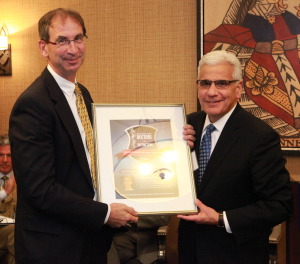According to the National Spinal Cord Injury Statistical Center, there are more than a quarter of a million people with serious spinal cord injuries. Each year, about 12,000 join the list of catastrophically injured individuals who suffer paralysis and possible impairments to vital functions, such as breathing and bowel movements, as well as suffer the emotional and psychological pain resulting from a quality of life that has been suddenly shattered.
It is hard to believe that not so long ago, the overall health implications of life-threatening spinal cord injuries were largely neglected. Yet, thanks to the groundbreaking research over the past 25 years that has been led by Dr. William A. Bauman of New Rochelle, the medical profession”™s understanding and treatment of serious spinal cord injuries has vastly improved. It is work that has been saving lives and improving the quality of life of veterans, which was instrumental in Bauman, along with his colleague Ann M. Spungen of Bronxville, in recently winning the Samuel J. Heyman Science and Environment Medal.
What the general public may not appreciate is that this is one of a number of seminal research studies that have long been undertaken and supported by Veterans Affairs at its James J. Peters VA Medical Center in the Bronx, where Bauman is director of the Rehabilitation R&D National Center of Excellence for the Medical Consequences of Spinal Cord Injury.

“In fact, since the Bronx VA was established in the 1940s, it has attracted the best and brightest minds to undertake investigations in a number of clinical areas,” Bauman said.
Bauman said he was mentored by Dr. Rosalyn Yalow, a Nobel Prize winner in medicine who also was the VA”™s most senior medical investigator. “She is one of several towering scientific investigators who laid the foundation for this center”™s reputation for breakthrough medical research,” he said.
In addition to Yalow”™s influence, Bauman”™s remarkable medical career was no doubt shaped early on by his parents, who were among the very few to be called a “power doctor couple,” a rarity even today. His late father, Arthur, served as chief of the endocrinology section of White Plains Hospital and did his fellowship with the VA. His mother, Caroline, after nearly 60 years still practices pediatric medicine in White Plains. His younger brother, Andrew, is also a VA physician at a facility in White River Junction, Vt., and teaches at Dartmouth College.
Against this backdrop, when Bauman joined the faculty of Mount Sinai School of Medicine in 1989, he established the Spinal Cord Damage Research Center at the VA center. “As I was trained as an endocrinologist just as my father was, I was interested in questions related to sugar and cholesterol metabolism in persons with spinal cord injury because they are markedly inactive and lose muscle and gain fat,” Bauman said. “Quickly, I realized that many of the most basic medical problems faced by those with spinal cord injury were not even identified, much less rigorously defined.”
Bauman said, “I had a passion for clinical investigation and this work was clearly before me to address because no one else appeared to have done it, nor was remotely poised to accomplish it in a systematic, comprehensive manner.”
The creation of the center was timely given that the VA maintains the largest single network of spinal cord injury care in the nation. Today, there are about 43,000 veterans with spinal cord injuries. “From the start, the driving force behind my work was the clear and obvious need to improve the general health of and quality of life for veterans with spinal cord injury,” Bauman said. He teamed with Spungen, who would become associate director of the unit. They and a staff of 30 researchers have produced medical advances and drug therapies to improve the lives of those with spinal cord injuries. One of their notable findings is that people with the injuries have an increased risk of heart disease. “We were also the first to describe and treat an asthma condition that is common to those with a higher level of paralysis,” Bauman said.
Homer S. Townsend Jr., executive director of Paralyzed Veterans of America, said the work of Bauman and Spungen “has led to advancements in understanding that undoubtedly have saved lives.”
Now, after a promising three-and-a-half-year pilot study with ReWalk, a wearable exoskeleton that enables individuals with paralysis to stand, walk and climb stairs, a proposal by Bauman”™s group to obtain a significant multimillion-dollar grant is undergoing final review. If approved, the funding from the VA”™s Clinical Science Research and Development Service”™s Cooperative Studies Program would make it possible to expand continued study of ReWalk as a viable intervention modality for veterans with spinal cord injuries at eight VA centers.
Bauman said results from the Bronx VA center”™s ReWalk study with about 12 veterans are very encouraging. “We saw that veterans who used ReWalk demonstrated improvements in mobility, bowel functions, sleep, muscle tone as well as overall well-being that comes with the ability to be able to move about the home and the community,” he said.
Bauman noted, “Although ReWalk is not for everyone, such as individuals with cardiac and lung problems or very weak bones, our study is a game changer. This is not only promising good news for veterans but for so many others in the U.S. who are seeking relief from the debilitating effects of (spinal cord injuries).”
“I along with my colleague Dr. Spungen and our team are so proud to be a part of the VA”™s extraordinary research program that continues to be at the vanguard in advancing the science of medicine.”



















